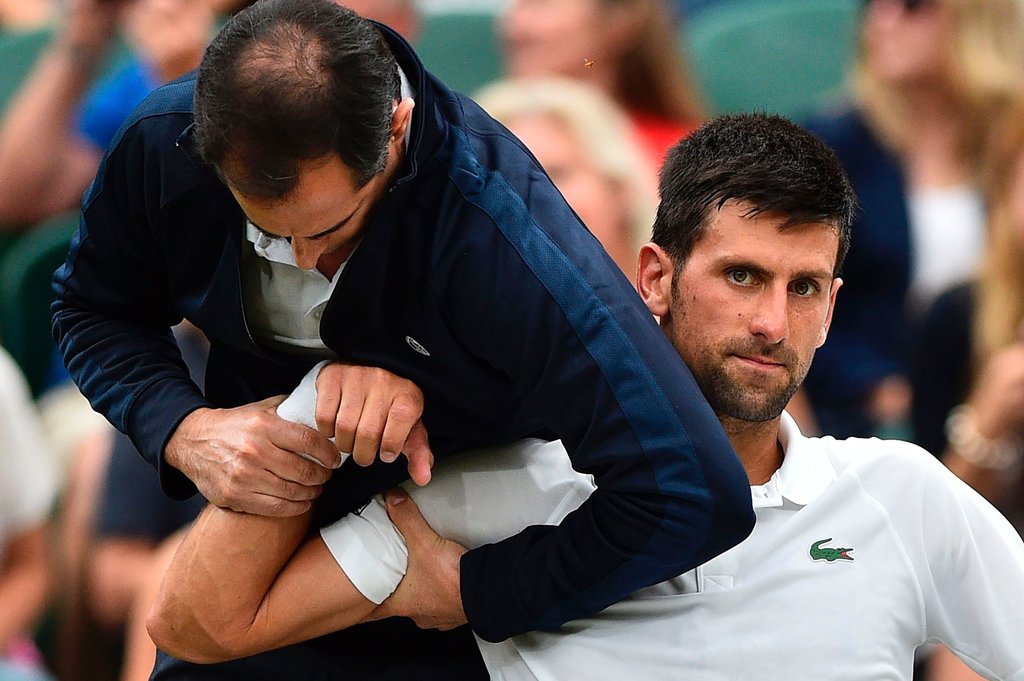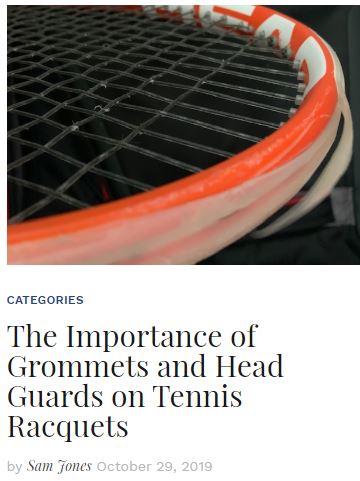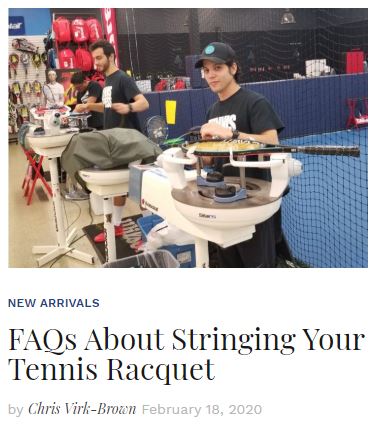Above is Novak Djokovic being treated for an elbow strain by the trainer at the Championships of Wimbledon (Source: July 26, 2017 – Glyn Kirk/Agence France-Presse – Getty Images)
The tennis playing community is a tightly-knit group. We bond over Federer’s majesty, Serena’s dominance, and the wonderful feel of a fresh grip on a tennis racquet. There is something else that brings us together; The fear, pain, and strain of Tennis Elbow.

Tennis elbow has a much cooler scientific name, lateral-epicondylitis. The condition is described as an over use injury of the elbow, specifically the forearm extensor muscles. It is interesting to note, so many sufferers of tennis elbow do not play tennis at all, but let’s stick with us tennisers for a few moments. Whether you are a beer league champion, avid tournament player, high schooler, or league tennis dominator, tennis elbow can shut you down, and break your spirits quickly. Here are some tips to help keep you on the court and pain free.
Rest
Before considering racquet, string, or tension changes, start with the most obvious – Rest. How often are you playing tennis? If the answer is “6 days a week and twice on Sunday”, then why not start with the some rest! I know rest is not a fun solution, particularly if tennis is your primary form of exercise. But what about active rest? Go for a short jog, or do some cycling or swimming. By cross-training a little bit, you are giving your elbow some rest, while maintaining your cardiovascular endurance.
On-court Evaluation
If, like me, you think rest is the worst and tennis must be played at any cost, consult a teaching professional for a half hour lesson. Explain to the pro the issues you are having with tennis elbow, and ask them if they see anything technically you are struggling with that could be exacerbating the issue. Tennis professionals are not doctors, but they absolutely want you to be able to keep playing tennis. Perhaps your contact point is to late on your forehand, or maybe you are short-arming the ball. Either way, most of us don’t have the ability to watch ourselves play tennis the way an instructor can.
String Guidelines
The first equipment adjustment to make would be lowering your string tension 4-5 pounds. There are many professional tennis players stringing their racquets in the 40-50 pound range. With a lower tension, the string bed will play more powerful and more comfortably. Second, you should find out what string you are currently using, and most importantly, what it is made of. Polyester strings are all the rage at the moment, but they do not dampen the impact shock at all. Strings that offer more flexibility and energy return like multifilament or natural gut, do a much better job of absorbing shock and protecting your arm. Because they are more pliable, they can be strung tighter for more control, without increasing shock to the elbow. If you loved the firmer response of a polyester string, but it is causing elbow discomfort, consider trying a thicker synthetic gut string or multifilament. With the larger string diameter, the string bed will offer more control, and you can still string with higher tensions while protecting your elbow.
Grip Tips
Pay attention to your racquet’s grip. What size is your grip? If you do not know the answer to this, you need to find out. (Check our Buyers’ Guide article) Using a grip that is too large causes you to strain your forearm when changing grips, and too small of a grip will force you to squeeze the handle tighter causing more fatigue. If the grip is particularly worn out and slippery, you will be straining your forearm to keep the racquet from twisting. I know some players decide they want a smaller size handle so they can remove the replacement grip and put an overgrip over the bare handle. The problem here is two fold: 1. The replacement grip has cushion built into it to keep it comfortable. 2. Using an overgrip only, will decrease the grip size, but offer no padding and no comfort. Doing this will also have an effect on the racquet’s balance as a replacement grip is much heavier than an overgrip. Some racquet brands produce a replacement grip with the specific goal of dampening vibration such as Wilson Shock Shield.
The Right Racquet
We have talked about string tensions and string types, lets talk about the racquet. Examine your racquet for a second. How thick is the beam? How heavy is it? Is it head-heavy or head-light? Though this can sound intimidating, all of this information is available on our website. Here are a few guidelines: Generally arm-friendly racquets have a lower RA rating (55-65), a medium weight (10.5-11 ounces), and a slightly head-light balance. If you swing really fast and have long swings, but are using an ultralight tennis racquet, this is probably causing some of your arm trouble. Using a firm racquet with polyester string is a double whammy of sorts for your arm. If you love the stiffer feeling racquet, consider a softer string. Pay attention to your racquet’s swing weight. The higher the number, the harder it is to move. A safe guideline for swing weight is between 300-320. Some racquets have swing weights above 330, this is an extraordinarily high number and is difficult to play with unless you are an expert level player. Generally speaking, a thicker frame cross section means it is a stiffer racquet and will provide more power, but less dampening.
Tennis Elbow can be a frustrating opponent, but by tweaking your existing equipment you might be able to resolve the issue and hopefully get back on the court pain free!
For More:





